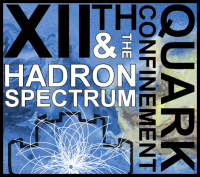Speaker
Description
Electromagnetic E1 (and M1) multipole transitions have been studied since the early days of hadron spectroscopy because they allow to access heavy quarkonium states which are below open-flavour threshold. Moreover, they are interesting by themselves because they are an important tool to check particular regions of the hadrons' wave function and thus to determine their internal structure and dynamics.
From a theoretical point of view, electromagnetic transitions between heavy quarkonium states have been treated for a long time by means of potential models using nonrelativistic reductions of phenomenological interactions. However, the progress made in effective field theories (EFTs) for studying heavy quarkonia and the new large set of accurate experimental data taken in the heavy quark sector by $B$-factories (BaBar, Belle and CLEO), $\tau$-charm facilities (CLEO-c, BESIII) and even proton-proton colliders (CDF, D0, LHCb, ATLAS, CMS) ask for a systematic and model-independent analysis.
This contribution aims to present the first numerical determination of the $2\,{}^{3}P_{J}\to 1{}^{3}S_{1}\gamma$ ($\chi_{bJ}(1P)\to \Upsilon(1S)\gamma$) decay rates within the low-energy EFT called potential NRQCD (pNRQCD). We assume that the heavy mesons involved in the studied reactions lie in the weak-coupling regime of pNRQCD and thus a full perturbative calculation can be performed. Relativistic corrections of relative order $v^{2}$ to the leading electric dipole operator are included. The analysis separates those contributions that account for the electromagnetic interaction terms in the pNRQCD Lagrangian, which are $v^{2}$ suppressed, and those that account for quarkonium state corrections of relative order $v^{2}$. Within the last ones, corrections come from higher-order potentials ($1/m$ and $1/m^2$ terms), and from higher Fock states which account for the coupling of the quark-antiquark state to other low-energy degrees of freedom and thus demand nonperturbative input.
